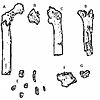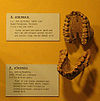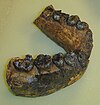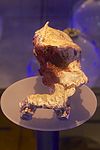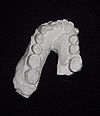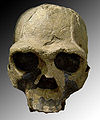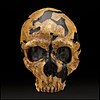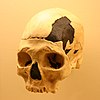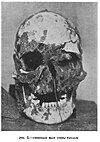Danh sách hóa thạch tiến hóa của con người
Bảng hóa thạch dưới đây cung cấp một cái nhìn tổng quan ngắn gọn về một số hóa thạch đáng chú ý của vượn dạng người đã phát hiện có liên quan đến quá trình tiến hóa của loài người, bắt đầu với sự hình thành của quần thể Hominini vào cuối Miocen, khoảng 6 Ma (Ma/Ka: Mega/Kilo annum, triệu/ngàn năm) trước.[1]
Vì có hàng ngàn hóa thạch, chủ yếu là rời rạc, thường bao gồm xương hay răng đơn lẻ, hiếm khi có hộp sọ hoàn chỉnh hay bộ xương, nên tổng quan này không thể coi là hoàn chỉnh [1]. Tuy nhiên nó hiển thị một số trong những phát hiện quan trọng nhất. Các hóa thạch được sắp xếp theo độ tuổi gần đúng theo số liệu của định tuổi bằng đồng vị phóng xạ và/hoặc định tuổi gia tăng (incremental dating). Tên của loài đại diện được nêu theo sự đồng thuận hiện hành nếu có. Nếu chưa có sự đồng thuận khoa học rõ ràng thì có ghi chú về cách phân loại khác có thể được chỉ định, và ý kiến khác nhau đó có thể tìm thấy trên trang của hóa thạch.
Hầu hết các hóa thạch được đưa ra không được coi là tổ tiên trực tiếp đến người Homo sapiens, nhưng liên quan chặt chẽ với tổ tiên trực tiếp của con người, và do đó rất quan trọng cho việc nghiên cứu của các dòng truyền thừa.
Danh sách[sửa | sửa mã nguồn]
Tham khảo[sửa | sửa mã nguồn]
- ^ a b “Prominent Hominid Fossils”. Truy cập ngày 31 tháng 8 năm 2015.
- ^ “Scientists find 7.2-million-year-old pre-human remains in the Balkans”. Phys.org. ngày 22 tháng 5 năm 2017. Truy cập ngày 24 tháng 5 năm 2017.
- ^ “Fossil Hominids: Toumai”. Talkorigins.org. ngày 31 tháng 7 năm 2002. Truy cập ngày 15 tháng 10 năm 2012.
- ^ “Bar 10200'”. Smithsonian National Museum of Natural History. Truy cập ngày 27 tháng 7 năm 2012.
- ^ “Ardipithecus kadabba”. efossils. Bản gốc lưu trữ ngày 11 tháng 5 năm 2014. Truy cập ngày 26 tháng 3 năm 2015.
- ^ Amos, Jonathan (ngày 1 tháng 10 năm 2009). “Fossil finds extend human story”. BBC News.
- ^ I. A. N., McDougall; Craig, Feibel (1999). “Numerical age control for the Miocene-Pliocene succession at Lothagam, a hominoid-bearing sequence in the northern Kenya Rift”. Journal of the Geological Society. 156: 731–745. doi:10.1144/gsjgs.156.4.0731.
- ^ a b c Hill, Andrew; Ward, Steven (1988). “Origin of the Hominidae: the record of African large hominoid evolution between 14 My and 4 My”. Yearbook of Physical Anthropology. 31 (59): 49–83. doi:10.1002/ajpa.1330310505.
- ^ Patterson B, Behrensmeyer AK, Sill WD (tháng 6 năm 1970). “Geology and fauna of a new Pliocene locality in north-western Kenya”. Nature. 226 (5249): 918–21. doi:10.1038/226918a0. PMID 16057594.Quản lý CS1: nhiều tên: danh sách tác giả (liên kết)
- ^ “lothagam mandible fragment”. Bản gốc lưu trữ ngày 16 tháng 7 năm 2011. Truy cập ngày 6 tháng 2 năm 2016.
- ^ Ward, Steven; Hill, Andrew. “Pliocene hominid partial mandible from Tabarin, Baringo, Kenya”. American Journal of Physical Anthropology. 72 (1): 21–37. doi:10.1002/ajpa.1330720104.
- ^ Heslip, Steven (2001). “Australopithecus anamensis”. Đã bỏ qua tham số không rõ
|archive url=(gợi ý|archive-url=) (trợ giúp)Bản mẫu:Self-published inline - ^ “Oldupai”. Ntz.info. Truy cập ngày 15 tháng 10 năm 2012.
- ^ “KNM-WT 40000”. Bản gốc lưu trữ ngày 10 tháng 11 năm 2013. Truy cập ngày 6 tháng 2 năm 2016.
- ^ Smithsonian
- ^ “New human ancestor species from Ethiopia lived alongside Lucy's species”. www.sciencedaily.com. Truy cập ngày 28 tháng 5 năm 2015.
- ^ “Image at Modern Human Origins”. Bản gốc lưu trữ ngày 29 tháng 8 năm 2010. Truy cập ngày 6 tháng 2 năm 2016.
- ^ “Image at Eurekalert”. Bản gốc lưu trữ ngày 4 tháng 6 năm 2020. Truy cập ngày 6 tháng 2 năm 2016.
- ^ Villmoare, Brian; Kimbel, William H.; Seyoum, Chalachew; Campisano, Christopher J.; DiMaggio, Erin N.; Rowan, John; Braun, David R.; Arrowsmith, J. Ramón; Reed, Kaye E. (ngày 20 tháng 3 năm 2015). “Early Homo at 2.8 Ma from Ledi-Geraru, Afar, Ethiopia”. Science. 347 (6228): 1352–55. Bibcode:2015Sci...347.1352V. doi:10.1126/science.aaa1343. ISSN 0036-8075. PMID 25739410. "The Gurumaha Tuff is radiometrically dated to 2842±0007 Ma, a date that is consistent with the normal magnetic polarity of the Gurumaha section, presumably the Gauss Chron. An upper bounding age for LD 350-1 is provided by an adjacent, downfaulted younger block that contains the 2665±0016 Ma Lee Adoyta Tuff. [...] the age of LD 350-1 can be further constrained by stratigraphic scaling. [...] Based on the current chronostratigraphic framework for Ledi-Geraru, we consider the age of LD 350-1 to be 2.80–2.75 Ma".
- ^ Bouri Vertebrate Paleontology “Australopithecus garhi: BOU-VP-12/130”. efossils. Bản gốc lưu trữ ngày 25 tháng 6 năm 2016. Truy cập ngày 13 tháng 3 năm 2021.
- ^ Image at Smithsonian
- ^ “Image at Modern Human Origins”. Bản gốc lưu trữ ngày 6 tháng 6 năm 2013. Truy cập ngày 6 tháng 2 năm 2016.
- ^ “Bản sao đã lưu trữ”. Bản gốc lưu trữ ngày 5 tháng 10 năm 2012. Truy cập ngày 6 tháng 2 năm 2016.
- ^ “Archived copy”. Bản gốc lưu trữ ngày 18 tháng 1 năm 2006. Truy cập ngày 11 tháng 7 năm 2006.Quản lý CS1: bản lưu trữ là tiêu đề (liên kết) Image at Modern Human Origins. “Australopithecus africanus”. Australian Museum. ngày 20 tháng 1 năm 2011.
- ^ Herries, Andy I.R.; Shaw, John (2011). “Palaeomagnetic analysis of the Sterkfontein palaeocave deposits: Implications for the age of the hominin fossils and stone tool industries”. Journal of Human Evolution. 60 (5): 523–39. doi:10.1016/j.jhevol.2010.09.001. ISSN 0047-2484. PMID 21392817.
- ^ a b c d Herries, Andy (2020). “Contemporaneity of Australopithecus, Paranthropus, and early Homo erectus in South Africa”. Science. 368 (6486): eaaw7293. doi:10.1126/science.aaw7293. hdl:11568/1040368. PMID 32241925. S2CID 214763272.
- ^ Martin, Jesse M.; Leece, A. B.; Neubauer, Simon; Baker, Stephanie E.; Mongle, Carrie S.; Boschian, Giovanni; Schwartz, Gary T.; Smith, Amanda L.; Ledogar, Justin A.; Strait, David S.; Herries, Andy I. R. (ngày 9 tháng 11 năm 2020). “Drimolen cranium DNH 155 documents microevolution in an early hominin species”. Nature Ecology & Evolution (bằng tiếng Anh). 5 (1): 38–45. doi:10.1038/s41559-020-01319-6. ISSN 2397-334X. PMID 33168991. S2CID 226296091.
- ^ “Modernhumanorigins.net”. www.modernhumanorigins.net. Bản gốc lưu trữ ngày 17 tháng 6 năm 2010. Truy cập ngày 18 tháng 3 năm 2007.
- ^ Department of Anthropology: The University of Texas at Austin. “Paranthropus robustus: TM 1517”. Bản gốc lưu trữ ngày 11 tháng 5 năm 2013. Truy cập ngày 9 tháng 6 năm 2014.
- ^ MH1 image at Scientific American
- ^ Juliet King (ngày 4 tháng 6 năm 2010). “Australopithecus sediba fossil named by 17-year-old Johannesburg student”. Origins Centre. Bản gốc lưu trữ ngày 25 tháng 3 năm 2012. Truy cập ngày 9 tháng 7 năm 2011.
- ^ Jonathan, Amos (ngày 8 tháng 9 năm 2011). “African fossils put new spin on human origins story”. http://www.sciencemag.org/site/extra/sediba/index.xhtml. BBC News. Truy cập ngày 9 tháng 9 năm 2011. Liên kết ngoài trong
|work=(trợ giúp) - ^ Mai, L.L., Owl, M.Y., & Kersting, M.P. (2005), p.286
- ^ Image at Smithsonian
- ^ “Modernhumanorigins.net”. www.modernhumanorigins.net. Bản gốc lưu trữ ngày 27 tháng 9 năm 2007. Truy cập ngày 18 tháng 3 năm 2007.
- ^ “Image at Smithsonian”. Bản gốc lưu trữ ngày 4 tháng 3 năm 2016. Truy cập ngày 6 tháng 2 năm 2016.
- ^ “OH 8 image of foot at Modern Human Origins”. Bản gốc lưu trữ ngày 8 tháng 12 năm 2010. Truy cập ngày 6 tháng 2 năm 2016.
- ^ a b c Leakey MG, Spoor F, Dean MC, và đồng nghiệp (tháng 8 năm 2012). “New fossils from Koobi Fora in northern Kenya confirm taxonomic diversity in early Homo”. Nature. 488 (7410): 201–4. doi:10.1038/nature11322. PMID 22874966.F
- ^ “Homo ergaster”. Australian Museum. Truy cập ngày 7 tháng 7 năm 2014.
- ^ “Inverted strata”. Bản gốc lưu trữ ngày 14 tháng 5 năm 2013. Truy cập ngày 6 tháng 2 năm 2016.
- ^ Donald C. Johanson, Blake Edgar (1996). From Lucy to Language. New York, NY: Simon & Schuster. tr. 158.
- ^ “Image at Smithsonian”. Bản gốc lưu trữ ngày 7 tháng 3 năm 2016. Truy cập ngày 6 tháng 2 năm 2016.
- ^ Leakey, R. E. F. y Walker, A. C. (1988). “New Australopithecus boisei specimens from East and West Lake Turkana, Kenya”. American Journal of Physical Anthropology. 76 (1): 1–24. doi:10.1002/ajpa.1330760102. ISSN 1096-8644. PMID 3136654.Quản lý CS1: sử dụng tham số tác giả (liên kết)
- ^ Grine, Frederick E. biên tập (2007). Evolutionary History of the "Robust" Australopithecines. Transaction Publishers. tr. 99, 185–186, 247. ISBN 9780202365961. Truy cập ngày 16 tháng 2 năm 2015.
- ^ “STW 53 image at Modern Human Origins”. Bản gốc lưu trữ ngày 12 tháng 4 năm 2010. Truy cập ngày 6 tháng 2 năm 2016.
- ^ “DNH 7 image at Modern Human Origins”. Bản gốc lưu trữ ngày 17 tháng 6 năm 2010. Truy cập ngày 6 tháng 2 năm 2016.
- ^ “Chellean OH 9 Image at Modern Human Origins”. Bản gốc lưu trữ ngày 17 tháng 6 năm 2010. Truy cập ngày 6 tháng 2 năm 2016.
- ^ Michael Hopkin (ngày 26 tháng 3 năm 2008). “Fossil find is oldest European yet”. Nature News. doi:10.1038/news.2008.691.
- ^ [1]
- ^ [2]
- ^ Image at Smithsonian
- ^ “Ternifine or Tighenif”. Bản gốc lưu trữ ngày 11 tháng 7 năm 2014. Truy cập ngày 28 tháng 3 năm 2015.
- ^ “Sangiran 17 image at Modern Human Origins”. Bản gốc lưu trữ ngày 6 tháng 1 năm 2010. Truy cập ngày 6 tháng 2 năm 2016.
- ^ archive.archaeology.org
- ^ “Bodo image at Modern Human Origins”. Bản gốc lưu trữ ngày 6 tháng 1 năm 2010. Truy cập ngày 6 tháng 2 năm 2016.
- ^ Saldanha man Bản mẫu:Self-published inline Được lưu trữ ngày 11 tháng 7 năm 2007 tại Wayback Machine
- ^ “Hexian PA830 image at Modern Human Origins”. Bản gốc lưu trữ ngày 6 tháng 6 năm 2013. Truy cập ngày 6 tháng 2 năm 2016.
- ^ Peter Brown. “Hexian”. Peter Brown's Australian & Asian Palaeoanthropology. Truy cập ngày 18 tháng 5 năm 2014.
- ^ Eric Delson, Ian Tattersall, John Van Couvering, Alison S. Brooks biên tập (2004). 6GFGsswTIO8C Encyclopedia of Human Evolution and Prehistory: Second Edition Kiểm tra giá trị
|url=(trợ giúp). Routledge. tr. 624. ISBN 9781135582289. Truy cập ngày 9 tháng 8 năm 2015.Quản lý CS1: nhiều tên: danh sách biên tập viên (liên kết)[liên kết hỏng] - ^ Smithsonian National Museum of Natural History. “Salé”. What does it mean to be human?. Truy cập ngày 18 tháng 5 năm 2014.
- ^ J. J. Jaeger (1975). “The mammalian faunas and hominid fossils of the Middle Pleistocene of the Maghreb”. Trong K.W.Butzer & G.Ll.Isaac (biên tập). After the Australopithecines. Den Hage. tr. 399–418. ISBN 978-9027976291.
- ^ “Image at Smithsonian”. Bản gốc lưu trữ ngày 4 tháng 3 năm 2016. Truy cập ngày 6 tháng 2 năm 2016.
- ^ The age of Homo naledi and associated sediments in the Rising Star Cave, South Africa. eLIFE, 09/05/2017. Truy cập 30/05/2017.
- ^ “Smithsonian's Human Origins Program”. Bản gốc lưu trữ ngày 2 tháng 2 năm 2015. Truy cập ngày 6 tháng 2 năm 2016.
- ^ [3]
- ^ “Dali image at Modern Human Origins”. Bản gốc lưu trữ ngày 28 tháng 8 năm 2010. Truy cập ngày 6 tháng 2 năm 2016.
- ^ P. Brown Dali archaic Homo SapiensBản mẫu:Self-published inline
- ^ Chen, T; Yang, Q; Wu, E (1994). “Antiquity of Homo sapiens in China”. Nature. 368: 55–56. doi:10.1038/368055a0.
- ^ “Omo 1 Image at Modern Human Origins”. Bản gốc lưu trữ ngày 18 tháng 8 năm 2010. Truy cập ngày 6 tháng 2 năm 2016.
- ^ “Omo II Image at Modern Human Origins”. Bản gốc lưu trữ ngày 13 tháng 1 năm 2010. Truy cập ngày 6 tháng 2 năm 2016.
- ^ Chang, C.-H.; Kaifu, M.; Kona, R. T.; Grün, R.; Matsu'ura, S.; Kinsley, L.; Lin, L.-K. (2015). “First archaic Homo from Taiwan”. Nature Communications. 6: 6037. doi:10.1038/ncomms7037.
- ^ Choi, Charles Q. (ngày 27 tháng 1 năm 2015). “Ancient Human Fossil Could Be New Primitive Species”. Live Science.
- ^ McMenamin, M. A. S. (2015). Homo tsaichangensis and Gigantopithecus. South Hadley, Massachusetts: Meanma. doi:10.13140/2.1.3463.7121. ISBN 1-893882-19-5.
- ^ Herto skull images at ABC Science
- ^ Jebel Irhoud 1 skull image at Max Planck Institute. Lưu trữ 2017-01-12 tại Wayback Machine
- ^ Smith TM, Tafforeau P, Reid DJ, và đồng nghiệp (tháng 4 năm 2007). “Earliest evidence of modern human life history in North African early Homo sapiens”. Proceedings of the National Academy of Sciences of the United States of America. 104 (15): 6128–33. doi:10.1073/pnas.0700747104. PMC 1828706. PMID 17372199. Tóm lược dễ hiểu – Phys.org (ngày 13 tháng 3 năm 2007).
- ^ Image of Altamura Man
- ^ “Image of Altamura Man skull”. Bản gốc lưu trữ ngày 23 tháng 10 năm 2013. Truy cập ngày 6 tháng 2 năm 2016.
- ^ Martina Lari, Fabio Di Vincenzo, Andrea Borsato, Silvia Ghirotto, Mario Micheli, Carlotta Balsamo, Carmine Collina, Gianluca De Bellis, Silvia Frisia, Giacomo Giacobini, Elena Gigli, John C. Hellstrom, Antonella Lannino, Alessandra Modi, Alessandro Pietrelli, Elena Pilli, Antonio Profico, Oscar Ramirez, Ermanno Rizzi, Stefania Vai, Donata Venturo, Marcello Piperno, Carles Lalueza-Fox, Guido Barbujani, David Caramelli, Giorgio Manzi (2015). “The Neanderthal in the karst: First dating, morphometric, and paleogenetic data on the fossil skeleton from Altamura (Italy)”. Journal of Human Evolution. in press: 88–94. doi:10.1016/j.jhevol.2015.02.007.Quản lý CS1: sử dụng tham số tác giả (liên kết)
- ^ “Tabun 1 Image at Modern Human Origins”. Bản gốc lưu trữ ngày 16 tháng 8 năm 2013. Truy cập ngày 6 tháng 2 năm 2016.
- ^ “Krapina C Images at Modern Human Origins”. Bản gốc lưu trữ ngày 27 tháng 9 năm 2007. Truy cập ngày 6 tháng 2 năm 2016.
- ^ a b c d e f g h i j Smith TM, Tafforeau P, Reid DJ, và đồng nghiệp (tháng 12 năm 2010). “Dental evidence for ontogenetic differences between modern humans and Neanderthals”. Proceedings of the National Academy of Sciences of the United States of America. 107 (49): 20923–8. doi:10.1073/pnas.1010906107. PMC 3000267. PMID 21078988.
- ^ Zimmer, Carl (ngày 16 tháng 11 năm 2015). “In a Tooth, DNA From Some Very Old Cousins, the Denisovans”. New York Times. Truy cập ngày 16 tháng 11 năm 2015.
- ^ Sawyer, Susanna; Renaud, Gabriel; Viola, Bence; Hublin, Jean-Jacques; Gansauge, Marie-Theres; Shunkov, Michael V.; Derevianko, Anatoly P.; Prüfer, Kay; Kelso, Janet; Pääbo, Svante (ngày 11 tháng 11 năm 2015). “Nuclear and mitochondrial DNA sequences from two Denisovan individuals”. PNAS. doi:10.1073/pnas.1519905112. Bản gốc lưu trữ ngày 20 tháng 11 năm 2015. Truy cập ngày 16 tháng 11 năm 2015.
- ^ “Qafzeh VI images at Modern Human Origins”. Bản gốc lưu trữ ngày 18 tháng 7 năm 2010. Truy cập ngày 6 tháng 2 năm 2016.
- ^ “Qafzeh IX”. Bản gốc lưu trữ ngày 27 tháng 9 năm 2007. Truy cập ngày 6 tháng 2 năm 2016.
- ^ “Qafzeh VI Image at Modern Human Origins”. Bản gốc lưu trữ ngày 18 tháng 7 năm 2010. Truy cập ngày 6 tháng 2 năm 2016.
- ^ “Klasies Images at Modern Human Origins”. Bản gốc lưu trữ ngày 10 tháng 6 năm 2010. Truy cập ngày 6 tháng 2 năm 2016.
- ^ Norton, Christopher J.; Braun, David R. Asian paleanthropology: From Africa to China and beyond. New York, NY: Springer. tr. 107. doi:10.1007/978-90-481-9094-2. ISBN 978-90-481-9093-5.
- ^ “What does it mean to be human?”. Smithsonian National Museum of Natural History. Bản gốc lưu trữ ngày 5 tháng 3 năm 2021. Truy cập ngày 27 tháng 7 năm 2012.
- ^ Johanson, Donald; Edgar, Blake (2006). From Lucy to Language. Simon & Schuster. ISBN 978-0-7432-8064-8.
- ^ “Amud 7 Image at Modern Human Origins”. Bản gốc lưu trữ ngày 16 tháng 7 năm 2011. Truy cập ngày 6 tháng 2 năm 2016.
- ^ a b Demeter, F.; Shackelford, L. L.; Bacon, A.-M.; Duringer, P.; Westaway, K.; Sayavongkhamdy, T.; Braga, J.; Sichanthongtip, P.; Khamdalavong, P.; Ponche, J.-L.; Wang, H.; Lundstrom, C.; Patole-Edoumba, E.; Karpoff, A.-M. (2012). “Anatomically modern human in Southeast Asia (Laos) by 46 ka”. Proceedings of the National Academy of Sciences. 109 (36): 14375–14380. doi:10.1073/pnas.1208104109. PMC 3437904. PMID 22908291.
- ^ Demeter, Fabrice; Shackelford, Laura; Westaway, Kira; Duringer, Philippe; Bacon, Anne-Marie; Ponche, Jean-Luc; Wu, Xiujie; Sayavongkhamdy, Thongsa; Zhao, Jian-Xin; Barnes, Lani; Boyon, Marc; Sichanthongtip, Phonephanh; Sénégas, Frank; Karpoff, Anne-Marie; Patole-Edoumba, Elise; Coppens, Yves; Braga, José; Macchiarelli, Roberto (2015). “Early Modern Humans and Morphological Variation in Southeast Asia: Fossil Evidence from Tam Pa Ling, Laos”. PLOS ONE. 10 (4): e0121193. doi:10.1371/journal.pone.0121193.
- ^ “Amud 1 Image at Modern Human Origins”. Bản gốc lưu trữ ngày 24 tháng 4 năm 2011. Truy cập ngày 6 tháng 2 năm 2016.
- ^ “Human evolution: interpreting evidence”. Museum of Science, Boston, US. Bản gốc lưu trữ ngày 2 tháng 5 năm 2004. Truy cập ngày 27 tháng 7 năm 2012.
- ^ “Mount Circeo 1 Image at Modern Human Origins”. Bản gốc lưu trữ ngày 30 tháng 5 năm 2011. Truy cập ngày 6 tháng 2 năm 2016.
- ^ “Neanderthal 1 images at Modern Human Origins”. Bản gốc lưu trữ ngày 20 tháng 6 năm 2010. Truy cập ngày 6 tháng 2 năm 2016.
- ^ Images of Peştera cu Oase Bản mẫu:Self-published inline
- ^ Timeline at Bone & Stone
- ^ “Predmosti 3 images at Modern Human Origins”. Bản gốc lưu trữ ngày 6 tháng 6 năm 2013. Truy cập ngày 6 tháng 2 năm 2016.
- ^ a b Schulting RJ, Trinkaus E, Higham T, Hedges R, Richards M, Cardy B (tháng 5 năm 2005). “A Mid-Upper Palaeolithic human humerus from Eel Point, South Wales, UK”. Journal of Human Evolution. 48 (5): 493–505. doi:10.1016/j.jhevol.2005.02.001. PMID 15857652.Quản lý CS1: nhiều tên: danh sách tác giả (liên kết)
- ^ “Minatogawa 1 images at Modern Human”. Bản gốc lưu trữ ngày 16 tháng 8 năm 2013. Truy cập ngày 6 tháng 2 năm 2016.
- ^ Freedman; Lofgren (1983). “Human skeletal ramins from Lake Tandou, New South Wales” (18). Arch Oceania: 98–105. Truy cập ngày 2 tháng 2 năm 2015. Đã bỏ qua tham số không rõ
|name2=(trợ giúp); Đã bỏ qua tham số không rõ|name=(trợ giúp); Chú thích journal cần|journal=(trợ giúp) - ^ “Lake Tandou Skull”. Australia: The Land Where Time Began. Truy cập ngày 19 tháng 5 năm 2014.
- ^ Stringer, C. B. (1985). “The hominid remains from Gough's Cave” (PDF). Proceedings of the University of Bristol Spelaeological Society. 17 (2): 145–52.
- ^ McKie, Robin (ngày 20 tháng 6 năm 2010). “Bones from a Cheddar Gorge cave show that cannibalism helped Britain's earliest settlers survive the ice age”. The Observer. Guardian. Truy cập ngày 15 tháng 10 năm 2012.
- ^ “Mystery of a West African skull from 13,000 years ago”. Natural History Museum, London, UK. Bản gốc lưu trữ ngày 2 tháng 8 năm 2012. Truy cập ngày 27 tháng 7 năm 2012.
- ^ Johnson, John. “Arlington Man”. National Park Service. Truy cập ngày 25 tháng 12 năm 2014.
- ^ Leroy-Gourhan, Michel Brézillon; preface by André (1969). Dictionnaire de la préhistoire . Paris: Larousse. ISBN 2-03-075437-4.
- ^ C. Smith (1999). “Who Was First? Untangling America's Prehistoric Roots”. Discovery Communications Inc. Bản gốc lưu trữ ngày 19 tháng 9 năm 2018. Truy cập ngày 2 tháng 7 năm 2014.
- ^ Bird, Junius B. (1988). “Four views of skull from skeleton 99.1/779”. Trong Hyslop, John (biên tập). Travels and Archaeology in South Chile. University of Iowa Press. tr. 214. ISBN 978-1-58729-014-5. Đã bỏ qua tham số không rõ
|chapter url=(trợ giúp) - ^ Travels and Archeology in South Chile. Cornell University, New York, U.S. Truy cập ngày 21 tháng 8 năm 2013.
- ^ Storm, Paul; Nelson, Andrew (1992). “The many faces of Wadjak man”. Archaeology Oceania. 27 (1): 37–46. doi:10.1002/j.1834-4453.1992.tb00281.x. JSTOR 40386932.
- ^ Seidler, Christoph (ngày 9 tháng 2 năm 2011). “Forscher entzaubern Steinzeitmann”. Der Spiegel (bằng tiếng Đức). Truy cập ngày 19 tháng 4 năm 2012.
- ^ Powell, Joseph F. (2005). The First Americans: Race, Evolution and the Origin of Native Americans (Google Books). Cambridge University Press. tr. 169–170. ISBN 9780521530354. Truy cập ngày 25 tháng 1 năm 2015.
- ^ Angel, J.L.; Phenice, T.W.; Robbins, L.H.; Lynch, B.M. (1980). Late stone age fishermen of Lothegam, Kenya. National Anthropological Archives, Sithsonian Institution, Part 3.
Xem thêm[sửa | sửa mã nguồn]
| Wikimedia Commons có thêm hình ảnh và phương tiện truyền tải về Danh sách hóa thạch tiến hóa của con người. |



